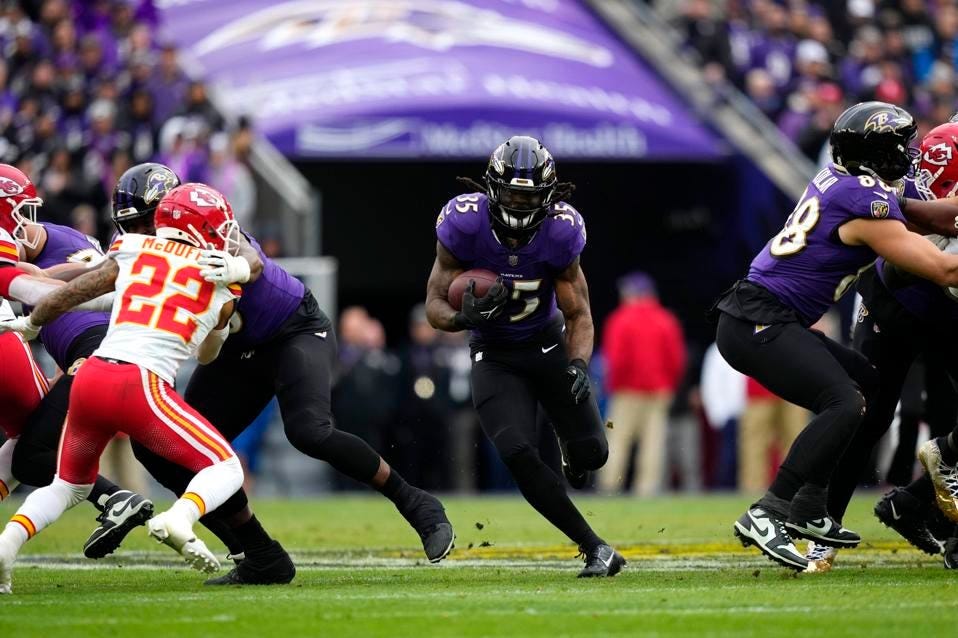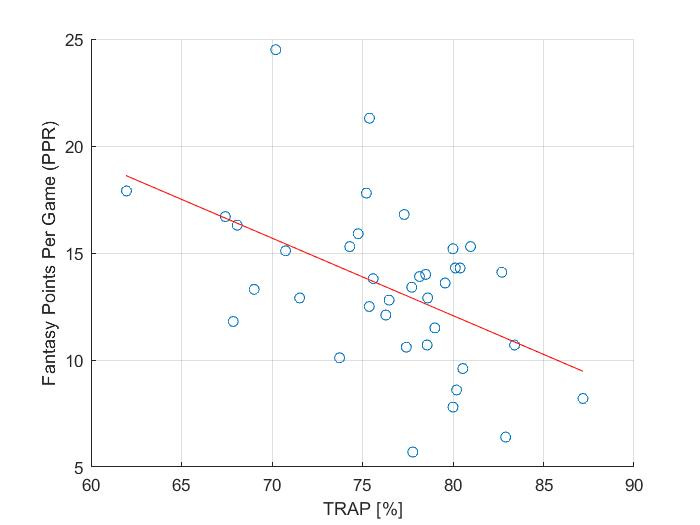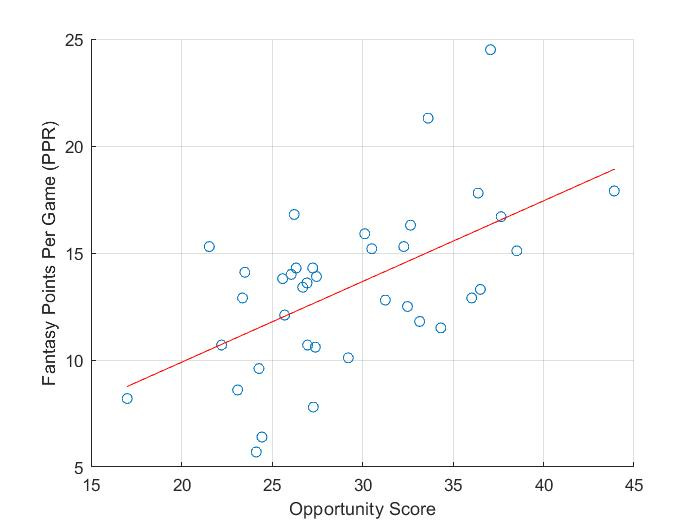I Created a Metric
Kind of... Adapting TRAP and observations on the running back position
I plan to focus more on macro strategy/game theory during these summer months. Outside of following news coming out of training camp from the different beat writers, there isn’t much we can takeaway. And even that feels like noise because it ultimately depends on whether the coach decides that player deserves to be on the field. A player can “impress” and still only end up playing a special teams role.
After sending out the stats review newsletter on running backs, I did some more digging into the three elements that make up a running back’s workload: receptions, green-zone rushes and non-green-zone rushes. It’s no surprise the conclusion remains the same—non-green-zone rushing attempts are clearly the least valuable of the three and are ultimately not that valuable at all.
I’m not here to talk about the insignificance of non-green-zone rushing attempts though. I already made my point there.
What is TRAP?
TRAP stands for trivial rush attempt percentage. It’s a metric introduced by Ben Gretch a few years ago to highlight the decline of bell-cow and rise of pass-catching running backs. I then discussed it here as one of the metrics to look for in RBs for fantasy production.
Again, if you divide the ways an RB scores fantasy points into three categories: receptions, rushing attempts inside the 10-yard line (green-zone), and rushing attempts outside the 10-yard line, TRAP is the percentage of opportunities that fall within the last category. So you could also call TRAP “non-green-zone rushing attempt percentage” but that doesn’t exactly roll of the tongue.
Receptions vs green-zone attempts
What I didn’t talk about was the other two elements, receptions and green-zone rushing attempts, at least how they compare to each other. I kind of just bucketed them together and said to go after guys who get a lot of them. So I want to revisit that. This is important because of the way RBs are used throughout the NFL. Many RBs that get used a lot in the passing game don’t get a lot of goal-line work and vice-versa. That makes the guys who get both super valuable, but what can also be beneficial to understand is whether one is more valuable than the other.
When using TRAP as a primary metric for analyzing RBs, I never knew what to do with guys like Derrick Henry and Gus Edwards, who don’t get a lot of receiving work but still put up big fantasy numbers. Because TRAP weighs both receptions and green-zone attempts equally, it will always favor the players with passing game usage because it’s much easier to get five targets in a game than it is five green-zone attempts. So the Gus Edwards like players look bad but we know those guys still have value.
When I charted TRAP, I considered players with a minimum of 150 touches to create a baseline. That gives us a sample of 41 players, which essentially includes anyone who was in the flex spot conversation if you assume two starting RBs. From this sample, the average number of fantasy points per green-zone touch was 12.36. The average fantasy points per reception was 5.78, not even half. So there’s a clear distinction. Green-zone rushing attempts are worth more than double what receptions are worth. That’s a significant enough difference that I didn’t feel right just breezing past while failing to mention the gap.
So what does this mean? In the same post I talked about the correlation between RB scoring and team scoring. Here’s what I said:
I still don’t think investing in high scoring offenses is a bad idea - it can be a useful factor to decide between two players with similar numbers in what might otherwise be a coinflip. The lesson here is to put more weight into the underlying volume numbers: how many carries/targets does a player get, how many goal-line/red-zone opportunities, how many tackles do they break? Those are the reasons why a player like Derrick Henry finished as the RB5 overall while playing for the 27th ranked offense.
I failed to recognize a couple things. The first is what I just mentioned about how goal-line opportunities (or green-zone touches) are much more valuable than targets. The other is how goal-line opportunities are almost entirely a factor of the offense a player plays in. So I want to walk back my comment a little.
While we don’t see as clean a correlation between team scoring and RB scoring as we might like, it still needs to be considered. In the end, green-zone rushes are correlated to team scoring, and fantasy points are correlated to green-zone rushes. So we should at least consider the team a player plays for, perhaps more than just a coinflip.
For example, here are the top-5 in green-zone touches along with their team scoring:
Christian McCaffrey | green-zone touches: 1st, team scoring: 1st, fantasy points: 1st
Joe Mixon | green-zone touches: 2nd, team scoring: 21st, fantasy points: 7th
Raheem Mostert | green-zone touches: T-3rd, team scoring: 2nd, fantasy points: 2nd
Kyren Williams | green-zone touches: T-3rd, team scoring: 8th, fantasy points: 3rd
Gus Edwards | green-zone touches: T-5th, team scoring: 3rd, fantasy points: 12th
Tony Pollard | green-zone touches: T-5th, team scoring: 5th, fantasy points: 21st
There are a couple outliers, Joe Mixon finished 2nd in green-zone touches despite playing for the 21st ranked offense, and Tony Pollard finished 21st in fantasy points despite having the 5th most green-zone touches. There will always be variance in these situations, but the trend is undeniable, RBs that get the goal-line work on high scoring offenses score a lot of fantasy points.
The metric
If we recall TRAP, which again is the percentage of total attempts that are neither receptions or green-zone rushing attempts, the graph looked like this.
Our example player, Gus Edwards, had a 79.0% TRAP, easily the highest among the other five players listed above (the next highest was 75.3%).
Instead of TRAP, going forward, I’ll be using a new metric I’m calling opportunity score. To calculate opportunity score, I’m simply taking the high-value touches (inverse of TRAP) and adding a multiplier to green-zone rushing attempts, while receptions maintain the same value. And, like TRAP, this is then divided by the number of total opportunities. To put it another way, opportunity score is just weighted green-zone rushing attempts plus receptions per total opportunities.
The goal is to account for the massive value touchdowns have in fantasy scoring. To compare to the graph above, here is opportunity score vs fantasy points per game using the same sample of players. And to make things less confusing, higher is better with opportunity score.
For the nerds out there like me who are curious, the root mean square error improves from 3.23 for TRAP to 3.05 for opportunity score.
Where opportunity score really shines is when comparing players whose goal-line usage vs receiving usage differs. The areas where TRAP misses. Gus Edwards, as we know had a high TRAP (79.0%). Jaylen Warren, on the other hand, had one of the lowest (67.8%), but conceded goal-line work to his teammate Najee Harris. Their PPG numbers were neighbors (11.5 vs 11.8) as were their opportunity scores (34.3 vs 33.2), despite being used in completely different ways.
One final point
Without knowing how much volume a player will get, we can’t get a clear picture of what a player will do for our fantasy teams. We don’t know how work much Blake Corum will take from Kyren Williams, or how much Trey Benson will take from James Conner. That’s why I like opportunity score, it is independent of volume but rather takes into account how a player is used in their offense.
So the takeaway from all of this is that we shouldn’t change course all that much. This isn’t a groundbreaking way of analyzing running backs. Players with pass-catching roles still have value and still have good opportunity scores, and I still plan to target them in drafts. I just like improving on my process/analysis where I can.
I plan to share players’ opportunity scores periodically when the season rolls around so we have an idea whose usage sets them up for success. But for now, my plan when choosing RBs is to look for guys who play on high-scoring offenses and who catch passes. If he checks both boxes, chances are he’ll be a success in fantasy.





I’d be curious to see this metric applied to players with even slightly less volume. Are there players who just missed the cut of 150 touches who could be poised for breakouts this year? Guys who were in minority roles last season but when they did get time had high opportunity scores? Thinking about guys like De’von Achane, Ty Chandler, Zamir White, Rico Dowdle, and Jaleel McLaughlin among others all fell in the 100-150 touch range.